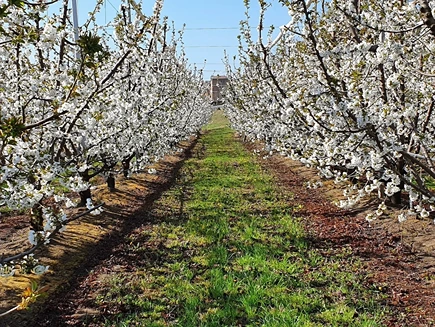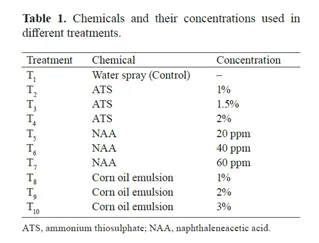Self-fertile cherry varieties, such as “Sweet Heart”, produce high yields but often result in small-sized and low-quality fruits. Managing the crop load in these cultivars is therefore essential to improve both yield and the organoleptic characteristics of the fruits. In a recent study from India, researchers evaluated the effectiveness of different chemical thinning agents applied at 80% full bloom to the “Sweet Heart” cultivar.

The thinning agents tested included ammonium thiosulfate (ATS) at concentrations of 1%, 1.5%, and 2%; naphthaleneacetic acid (NAA) at 20, 40, and 60 ppm; and a corn oil emulsion at 1%, 2%, and 3%.
The results showed a negative correlation between fruit number and quality: reducing the fruit load increased the availability of photosynthates for the remaining fruits, leading to improvements in fruit size and chemical composition. Among the treatments analyzed, ATS at 2% and NAA at 60 ppm were the most effective, reducing the number of fruits by 41.85% and 50.17%, respectively.
This reduction resulted in a significant increase in fruit weight, volume, and diameter, as well as an improvement in the soluble solids/acids (SSC/acid) ratio, an important parameter for taste.
 Tabella 1: Sostanze chimiche e relative concentrazioni utilizzate nei diversi trattamenti.
Tabella 1: Sostanze chimiche e relative concentrazioni utilizzate nei diversi trattamenti.
The application of thinning agents also influenced vegetative growth, with increases in annual shoot extension and leaf area observed. However, higher concentrations, such as ATS at 2%, caused a slight decrease in chlorophyll content in the leaves, which the authors attribute to an internal rebalancing of the plant.
Fruit color parameters also improved with the use of thinning agents: reducing the fruit load promoted faster accumulation of anthocyanin pigments, giving the fruits a more intense and vibrant hue.
While less effective than conventional chemical thinners, corn oil showed interesting potential for organic production, providing an ecological, safe, and cost-effective solution. This treatment reduced the fruit load and improved certain quality parameters, although not as effectively as ATS and NAA.
 Tabella 3: Effetto dei diradatori di fiori sul peso dei frutti, sull'aumento del peso dei frutti, sul peso dei noccioli, sul peso della polpa e sul rapporto frutti/noccioli della ciliegia dolce cv. 'Sweet Heart'. Tabella 4: Effetto dei diradatori di fiori sul volume dei frutti, sulla compattezza, sulla lunghezza del pedicello e del nocciolo della ciliegia dolce cv. 'Sweet Heart'.
Tabella 3: Effetto dei diradatori di fiori sul peso dei frutti, sull'aumento del peso dei frutti, sul peso dei noccioli, sul peso della polpa e sul rapporto frutti/noccioli della ciliegia dolce cv. 'Sweet Heart'. Tabella 4: Effetto dei diradatori di fiori sul volume dei frutti, sulla compattezza, sulla lunghezza del pedicello e del nocciolo della ciliegia dolce cv. 'Sweet Heart'.
The study also highlighted how thinning positively affected the return bloom in the following year. More intensive treatments, by reducing resource competition from fruits, promoted the formation of new flower buds. However, a slight decrease in total yield per tree was observed, as the total number of fruits decreased. Despite this, the increase in fruit quality and size more than compensated for the quantitative loss, offering a superior product that is better appreciated by consumers and the market.
In conclusion, blossom thinning is a crucial technique for optimizing production in self-fertile cherry cultivars like “Sweet Heart”. ATS at 2% and NAA at 60 ppm proved to be the most effective thinning treatments for improving fruit quality, while corn oil offers a viable alternative for organic farming methods. Moreover, these oil emulsions (such as corn oil) have the added advantages of being safe, low-cost, and sustainable.
Source: Mir, U. P., Mir, M. M., Rehman, M. U., Iqbal, U., Khan, S. Q., Khan, F. A., ... & Kaushik, P. (2024). Regulation of crop load and quality in sweet cherry cv. “Sweet Heart” using blossom thinning. Folia Horticulturae, 36(2), 311-321. https://doi.org/10.2478/fhort-2024-0020.
Images: Mir Uzma Parveze et al., 2025; SL Fruit Service
Andrea Giovannini
University of Bologna (IT)
Cherry Times - All rights reserved















